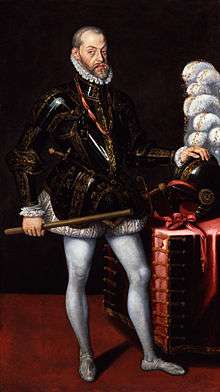Spanish Armada
The Spanish Armada (Spanish: Grande y Felicísima Armada, lit. 'Great and Most Fortunate Navy') was a Habsburg Spanish fleet of 130 ships that sailed from Corunna in late May 1588, under the command of the Duke of Medina Sidonia, with the purpose of escorting an army from Flanders to invade England. Medina Sidonia was an aristocrat without naval command experience but was made commander by King Philip II. The aim was to overthrow Queen Elizabeth I and her establishment of Protestantism in England, to stop English interference in the Spanish Netherlands and to stop the harm caused by English and Dutch privateering ships that interfered with Spanish interests in the Americas.
English ships sailed from Plymouth to attack the Armada and were faster and more manoeuvrable than the larger Spanish galleons, enabling them to fire on the Armada without loss as it sailed east off the south coast of England. The Armada could have anchored in The Solent between the Isle of Wight and the English mainland and occupied the Isle of Wight, but Medina Sidonia was under orders from King Philip II to meet up with the Duke of Parma's forces in the Netherlands so England could be invaded by Parma's soldiers and other soldiers carried in ships of the Armada. English guns damaged the Armada and a Spanish ship was captured by Sir Francis Drake in the English Channel.
The Armada anchored off Calais.[25] While awaiting communications from the Duke of Parma, the Armada was scattered by an English fireship night attack and abandoned its rendezvous with Parma's army, that was blockaded in harbour by Dutch flyboats. In the ensuing Battle of Gravelines, the Spanish fleet was further damaged and was in risk of running aground on the Dutch coast when the wind changed. The Armada, driven by southwest winds, withdrew north, with the English fleet harrying it up the east coast of England. On return to Spain round the north of Scotland and south around Ireland, the Armada was disrupted further by storms. Many ships were wrecked on the coasts of Scotland and Ireland and more than a third of the initial 130 ships failed to return.[26] As Martin and Parker explain, "Philip II attempted to invade England, but his plans miscarried. This was due to his own mismanagement, including the appointment of an aristocrat without naval experience as commander of the Armada, but also to unfortunate weather, and the opposition of the English and their Dutch allies, which included the use of fireships sailed into the anchored Armada."[27]
The expedition was the largest engagement of the undeclared Anglo-Spanish War (1585–1604). The following year, England organised a similar large-scale campaign against Spain, the English Armada, sometimes called the "counter-Armada of 1589", which was also unsuccessful.[28]
Etymology
The word armada is from the Spanish: armada, which is cognate with English army. Originally from the Latin: armāta, the past participle of armāre, 'to arm', used in Romance languages as a noun for armed force, army, navy, fleet.[29] Armada Española is still the Spanish term for the modern Spanish Navy.
History
Background
Henry VIII began the English Reformation as a political exercise over his desire to divorce his first wife, Catherine of Aragon. Over time, it became increasingly aligned with the Protestant reformation taking place in Europe, especially during the reign of Henry's son, Edward VI. Edward died childless and his half-sister, Mary I, ascended the throne. A devout Catholic, Mary, with her co-monarch and husband, Philip II of Spain, began to reassert Roman influence over church affairs. Her attempts led to more than 260 people being burned at the stake, earning her the nickname 'Bloody Mary'.[30]
Mary's death in 1558 led to her half-sister, Elizabeth I, taking the throne. Unlike Mary, Elizabeth was firmly in the reformist camp, and quickly reimplemented many of Edward's reforms. Philip, no longer co-monarch, deemed Elizabeth a heretic and illegitimate ruler of England. In the eyes of the Catholic Church, Henry had never officially divorced Catherine, making Elizabeth illegitimate. It is alleged that Phillip supported plots to have Elizabeth overthrown in favour of her Catholic cousin and heir presumptive, Mary, Queen of Scots. These plans were thwarted when Elizabeth had the Queen of Scots imprisoned and executed in 1587. Elizabeth retaliated against Philip by supporting the Dutch revolt against Spain, as well as funding privateers to raid Spanish ships across the Atlantic. She had also negotiated an enduring trade and political alliance with Morocco.
In retaliation, Philip planned an expedition to invade England in order to overthrow Elizabeth and, if the Armada was not entirely successful, at least negotiate freedom of worship for Catholics and financial compensation for war in the Low Countries.[31] Through this endeavour, English material support for the United Provinces, the part of the Low Countries that had successfully seceded from Spanish rule, and English attacks on Spanish trade and settlements[32] in the New World would end. The King was supported by Pope Sixtus V, who treated the invasion as a crusade, with the promise of a subsidy should the Armada make land.[33] Substantial support for the invasion was also expected from English Catholics, including wealthy and influential aristocrats and traders.[34]
A raid on Cádiz, led by Francis Drake in April 1587, had captured or destroyed about 30 ships and great quantities of supplies, setting preparations back by a year.[35] There is also evidence that a letter from Elizabeth's security chief and spymaster, Sir Francis Walsingham, to her ambassador in Istanbul, William Harborne, sought to initiate Ottoman Empire fleet manoeuvres to harass the Spaniards,[36] but there is no evidence for the success of that plan. Philip initially favoured a triple attack, starting with a diversionary raid on Scotland, while the main Armada would capture the Isle of Wight, or Southampton, to establish a safe anchorage in The Solent. The Duke of Parma would then follow with a large army from the Low Countries crossing the English Channel. Parma was uneasy about mounting such an invasion without any possibility of surprise. The appointed commander of the Armada was the highly experienced Álvaro de Bazán, Marquis of Santa Cruz, but he died in February 1588, and the Duke of Medina Sidonia, a high-born courtier, took his place. While a competent soldier and distinguished administrator, Medina Sidonia had no naval experience. He wrote to Philip expressing grave doubts about the planned campaign, but his message was prevented from reaching the King by courtiers on the grounds that God would ensure the Armada's success.[37]
Execution
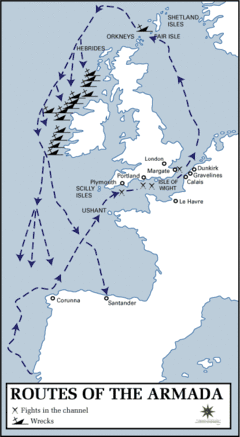
Prior to the undertaking, Pope Sixtus V allowed Philip II of Spain to collect crusade taxes and granted his men indulgences. The blessing of the Armada's banner on 25 April 1588 was similar to the ceremony used prior to the Battle of Lepanto in 1571. On 28 May 1588, the Armada set sail from Lisbon and headed for the English Channel. The fleet was composed of 130 ships, 8,000 sailors and 18,000 soldiers, and bore 1,500 brass guns and 1,000 iron guns. The full body of the fleet took two days to leave port. It included 28 purpose-built warships, of which 20 were galleons, four were galleys and four were (Neapolitan) galleasses. The remaining heavy vessels were mostly armed carracks and hulks, along with 34 light ships.[38]
In the Spanish Netherlands, 30,000 soldiers[39] awaited the arrival of the Armada, the plan being to use the cover of the warships to convey the army on barges to a place near London. In all, 55,000 men were to have been mustered, a huge army for that time. On the day the Armada set sail, Elizabeth's ambassador in the Netherlands, Valentine Dale, met Parma's representatives in peace negotiations. The English made a vain effort to intercept the Armada in the Bay of Biscay. On 6 July, negotiations were abandoned and the English fleet stood prepared, if ill-supplied, at Plymouth, awaiting news of Spanish movements. The English fleet outnumbered that of the Spanish, 200 ships to 130,[40] while the Spanish fleet outgunned that of the English. The Spanish available firepower was 50 percent more than that of the English.[41] The English fleet consisted of the 34 ships of the Royal Fleet, 21 of which were galleons of 200 to 400 tons, and 163 other ships, 30 of which were of 200 to 400 tons and carried up to 42 guns each. Twelve of the ships were privateers owned by Lord Howard of Effingham, Sir John Hawkins and Sir Francis Drake.[11]
The Armada was delayed by bad weather. Storms in the Bay of Biscay forced four galleys and one galleon to turn back, and other ships had to put in for repairs, leaving only about 124 ships to actually make it to the English Channel. Nearly half the fleet were not built as warships and were used for duties such as scouting and dispatch work, or for carrying supplies, animals and troops.[38]
The fleet was sighted in England on 19 July when it appeared off the Lizard in Cornwall. The news was conveyed to London by a system of beacons that had been constructed all the way along the south coast. On 19 July, the English fleet was trapped in Plymouth Harbour by the incoming tide. The Spanish convened a council of war, where it was proposed to ride into the harbour on the tide and incapacitate the defending ships at anchor. From Plymouth Harbour the Spanish would attack England, but Philip II explicitly forbade Medina Sidonia from acting, leaving the Armada to sail on to the east and toward the Isle of Wight. As the tide turned, 55 English ships set out to confront the Armada from Plymouth under the command of Lord Howard of Effingham, with Sir Francis Drake as Vice Admiral. The rear admiral was Sir John Hawkins.
First actions (1588)
On 20 July, the English fleet was off Eddystone Rocks with the Armada upwind to the west. To execute its attack, the English tacked upwind of the Armada, thus gaining the weather gage, a significant advantage. At daybreak on 21 July, the English fleet engaged the Armada off Plymouth near the Eddystone rocks. The Armada was in a crescent-shaped defensive formation, convex toward the east. The galleons and great ships were concentrated in the centre and at the tips of the crescent's horns, giving cover to the transports and supply ships in between. Opposing them, the English were in two sections, with Drake to the north in Revenge with 11 ships, and Howard to the south in Ark Royal with the bulk of the fleet.
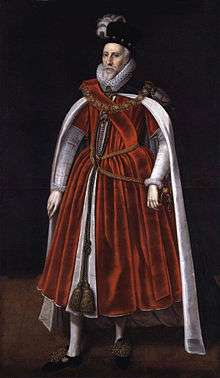
Given the Spanish advantage in close-quarter fighting, the English ships used their superior speed and manoeuvrability to keep beyond grappling range and bombarded the Spanish ships from a distance with cannon fire. The distance was too great for the manoeuvre to be effective and, at the end of the first day's fighting, neither fleet had lost a ship in action, although the Spanish carrack Rosario and galleon San Salvador were abandoned after they collided. When night fell, Francis Drake turned his ship back to loot the abandoned Spanish ships, capturing supplies of much-needed gunpowder and gold. Drake had been guiding the English fleet by means of a lantern, which he snuffed out to slip away from the Spanish ships, causing the rest of his fleet to become scattered and disarrayed by dawn. It took a day for the English fleet to regroup and the Armada gained a day's grace.[42] The English ships again used their superior speed and manoeuvrability to catch up with the Spanish fleet after a day of sailing.
The English fleet and the Armada engaged once more on 23 July, off Portland. A change of wind gave the Spanish the weather gage, and they sought to close with the English, but were foiled by the smaller ships' greater manoeuvrability. At one point, Howard formed his ships into a line of battle to attack at close range, bringing all his guns to bear, but he did not follow through with the manoeuvre and little was achieved.
If the Armada could create a temporary base in the protected waters of the Solent, a strait separating the Isle of Wight from the English mainland, it could wait there for word from Parma's army. However, in a full-scale attack, the English fleet broke into four groups with Martin Frobisher of the ship Aid given command over a squadron, and Drake coming with a large force from the south. Medina Sidonia sent reinforcements south and ordered the Armada back to open sea to avoid The Owers shoals.[43] There were no other secure harbours further east along England's south coast, so the Armada was compelled to make for Calais, without being able to wait for word of Parma's army.
On 27 July, the Armada anchored off Calais in a tightly-packed defensive crescent formation, not far from Dunkirk, where Parma's army, reduced by disease to 16,000, was expected to be waiting, ready to join the fleet in barges sent from ports along the Flemish coast. Communication was more difficult than anticipated and word came too late that the Parma army had yet to be equipped with sufficient transport or to be assembled in the port, a process that would take at least six days. Medina Sidonia waited at anchor and Dunkirk was blockaded by a Dutch fleet of 30 flyboats under Lieutenant-Admiral Justinus of Nassau.[44] Parma wanted the Armada to send its light pataches to drive away the Dutch, but Medina Sidonia would not send them because he feared he would need these ships for his own protection. There was no deep-water port where the fleet might shelter, always acknowledged as a major difficulty for the expedition, and the Spanish found themselves vulnerable as night drew on.
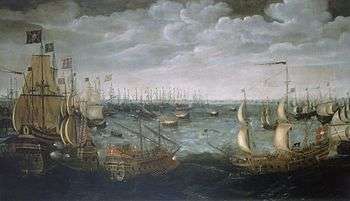
The Dutch flyboats mainly operated in the shallow waters off Zeeland and Flanders where larger warships with a deeper draught, like the Spanish and English galleons, could not safely enter. The Dutch enjoyed an unchallenged naval advantage in these waters, even though their navy was inferior in naval armament. An essential element of the plan of invasion, as it was eventually implemented, was the transportation of a large part of Parma's army of Flanders as the main invasion force in unarmed barges across the English Channel. These barges would be protected by the large ships of the Armada. However, to get to the Armada, they would have to cross the zone dominated by the Dutch navy, where the Armada could not go. This problem seems to have been overlooked by the Spanish planners, but it was insurmountable. Because of this obstacle, England never was in any real danger, at least from the Duke of Parma and the Army of Flanders. Because of the eventual English victory at sea, the Army of Flanders escaped the drowning death Justinus had in mind for them.[45][46]
At midnight on 28 July, the English set alight eight fireships, sacrificing regular warships by filling them with pitch, brimstone, gunpowder and tar, and cast them downwind among the closely anchored vessels of the Armada. The Spanish feared that these uncommonly large fireships were "hellburners",[47] specialised fireships filled with large gunpowder charges that had been used to deadly effect at the Siege of Antwerp. Two were intercepted and towed away, but the remainder bore down on the fleet. Medina Sidonia's flagship and the principal warships held their positions, but the rest of the fleet cut their anchor cables and scattered in confusion. No Spanish ships were burnt, but the crescent formation had been broken, and the fleet now found itself too far leeward of Calais in the rising southwesterly wind to recover its position. The English closed in for battle.
Battle of Gravelines
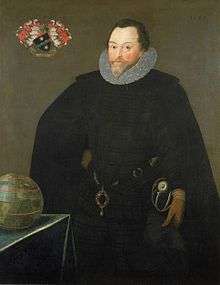
The small port of Gravelines was part of Flanders in the Spanish Netherlands close to the border with France, and the closest Spanish territory to England. Medina Sidonia tried to regather his fleet there and was reluctant to sail further east, knowing the danger from the shoals off Flanders, from which his Dutch enemies had removed the sea marks. The English learned of the Armada's weaknesses during the skirmishes in the English Channel and concluded it was necessary to close to within 100 yards (91 m) to penetrate the oak hulls of the Spanish ships. They had spent most of their gunpowder in the first engagements and had, after the Isle of Wight, been forced to conserve their heavy shot and powder for a final attack near Gravelines. During all the engagements, the Spanish heavy guns could not easily be reloaded because of their close spacing and the quantities of supplies stowed between decks, as Francis Drake had discovered on capturing the damaged Nuestra Señora del Rosario in the channel.[48] Instead, the gunners fired once and then transferred to their main task, which was to board enemy ships as had been the practice in naval warfare at the time. Evidence from Armada wrecks in Ireland shows that much of the fleet's ammunition was never spent.[49] Its determination to fight by boarding, rather than employing cannon fire at a distance, proved a weakness for the Spanish. The manoeuvre had been effective in the battles of Lepanto and Ponta Delgada (1582), but the English were aware of it and sought to avoid it by keeping their distance.
With its superior manoeuvrability, the English fleet provoked Spanish fire while staying out of range. The English then closed, firing damaging broadsides into the enemy ships, which enabled them to maintain a windward position, so the heeling Armada hulls were exposed to damage below the water line when they changed course later. Many of the Spanish gunners were killed or wounded by the English broadsides, and the task of manning the cannon often fell to the regular foot soldiers who did not know how to operate them. The ships were close enough for sailors on the upper decks of the English and Spanish ships to exchange musket fire. After eight hours, the English ships began to run out of ammunition, and some gunners began loading objects such as chains into cannons. Around 4 p.m., the English fired their last shots and pulled back.[50]
Five Spanish ships were lost. The galleass San Lorenzo, flagship of Don Hugo de Moncada, ran aground at Calais and was taken by Howard after fighting between the crew, galley slaves, English, and the French. The galleons San Mateo and San Felipe drifted away in a sinking condition, ran aground on the island of Walcheren the next day and were taken by the Dutch. One carrack ran aground near Blankenberge and another foundered. Many other Spanish ships were severely damaged, especially the Portuguese and some Spanish Atlantic-class galleons, including some Neapolitan galleys, which bore the brunt of the fighting during the early hours of the battle. The Spanish plan to join with Parma's army had been defeated.
Elizabeth's Tilbury speech
Because of the threat of invasion from the Netherlands, Robert Dudley, Earl of Leicester assembled a force of 4,000 militia at West Tilbury, Essex, to defend the Thames Estuary against any incursion up-river toward London.
Because the result of the English fireship attack and the sea battle of Gravelines had not yet reached England, on 8 August (18 August New Style), Elizabeth went to Tilbury to review her forces, arriving on horseback in ceremonial armour to imply to the militia she was prepared to lead them in the ensuing battle. She gave to them her royal address, which survives in at least six slightly different versions.[51] One version is as follows:
.jpg)
My loving people, we have been persuaded by some that are careful of our safety, to take heed how we commit ourselves to armed multitudes for fear of treachery; but, I do assure you, I do not desire to live to distrust my faithful and loving people. Let tyrants fear, I have always so behaved myself, that under God I have placed my chiefest strength and safeguard in the loyal hearts and goodwill of my subjects; and, therefore, I am come amongst you as you see at this time, not for my recreation and disport, but being resolved, in the midst and heat of battle, to live or die amongst you all – to lay down for my God, and for my kingdoms, and for my people, my honour and my blood even in the dust. I know I have the body of a weak and feeble woman; but I have the heart and stomach of a king – and of a King of England too, and think foul scorn that Parma or Spain, or any prince of Europe, should dare to invade the borders of my realm; to which, rather than any dishonour should grow by me, I myself will take up arms – I myself will be your general, judge, and rewarder of every one of your virtues in the field. I know already, for your forwardness, you have deserved rewards and crowns, and, we do assure you, on the word of a prince, they shall be duly paid you. In the mean time, my lieutenant general shall be in my stead, than whom never prince commanded a more noble or worthy subject; not doubting but by your obedience to my general, by your concord in the camp, and your valour in the field, we shall shortly have a famous victory over those enemies of my God, of my kingdom, and of my people.[52]
After the victory, typhus swept the English ships, beginning among the 500-strong crew of the Elizabeth Jonas and killing many mariners. The sailors were not paid for their service and many died of the disease and starvation after landing at Margate.[53]:144–148
Return to Spain

On the day after the battle of Gravelines, the disorganised and unmanoeuvrable Spanish fleet was at risk of running on to the sands of Zeeland due to the westerly component in the wind. Luckily for the Armada, the wind then changed to the south, enabling the fleet to sail north. The English ships under Howard pursued to prevent any landing on English soil, although by this time his ships were almost out of shot. On 2 August, Howard called a halt to the pursuit at about the latitude of the Firth of Forth off Scotland. The only option left to the Spanish ships was to return to Spain by sailing round the north of Scotland and home via the Atlantic or the Irish sea. The Spanish ships were beginning to show wear from the long voyage and some were kept together by having their damaged hulls strengthened with cables. Supplies of food and water ran short. The intention would have been to keep to the west of the coast of Scotland and Ireland in the relative safety of the open sea. There being no way of accurately measuring longitude, the Spanish were not aware that the Gulf Stream was carrying them north and east as they tried to move west and they eventually turned south much closer to the coast than they thought. Off Scotland and Ireland, the fleet ran into a series of powerful westerly winds which drove many of the damaged ships further toward the lee shore. Because so many anchors had been abandoned during the escape from the English fireships off Calais, many of the ships were incapable of securing shelter as the fleet reached the coast of Ireland and were driven onto the rocks and local inhabitants looted the ships. The late 16th century and especially 1588 was marked by unusually strong North Atlantic storms, perhaps associated with a high accumulation of polar ice off the coast of Greenland, a characteristic phenomenon of the "Little Ice Age".[54] More ships and sailors were lost to cold and stormy weather than in direct combat.
About 5,000 men died by drowning, starvation and slaughter by local inhabitants after their ships were driven ashore on the west coast of Scotland and Ireland.[55] Reports of the passage of the remnants of the Spanish Armada around Ireland abound with onerous accounts of hardships and survival.[56]


In the end, 67 ships and fewer than 10,000 men survived.[57] Many of the men were near death from disease, as the conditions were very cramped and most of the ships ran out of food and water. Some were captured and imprisoned by the English in what was later called the "Spanish Barn" in Torquay on the south coast of England. More Armada survivors later died in Spain or on hospital ships in Spanish harbours from diseases contracted during the voyage. It was reported that when Philip II learned of the result of the expedition, he declared, "I sent the Armada against men, not God's winds and waves".[58]
Aftermath
In England, a medal was struck with the inscription "Flavit Jehovah et Dissipati Sunt", which translates as "Jehovah blew with His winds, and they were scattered".
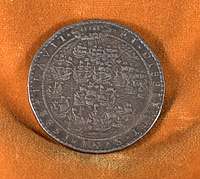
The wind that scattered the Armada has been called the Protestant Wind,[59] a phrase also used for later navy attacks favourable to the Protestant cause that were helped by the wind.
The following year the English launched the Counter Armada, with 23,375 men and 150 ships under Sir Francis Drake, but thousands were killed, wounded or died of disease[60][61][62] and 40 ships sunk or captured.[63] The attempt to restore the Portuguese Crown from Spain was unsuccessful and the opportunity to strike a decisive blow against the weakened Spanish navy was lost. The failure of the expedition depleted the financial resources of England's treasury, which had been carefully restored during the long reign of Elizabeth I.
During the course of the war the Spanish failed to gain control of the English Channel, or stop the English intervention in Flanders or English privateer transatlantic raids. Although substantially weaker than the great armada sent in 1588, two more armadas were sent by Spain in 1596 and 1597, but both were once more scattered by storms.[64] Nevertheless, through Philip II's naval revival the English and Dutch ultimately failed to disrupt the various fleets of the Indies despite the great number of military personnel mobilised every year. Thus, Spain remained the predominant power in Europe for several decades.[65]
The conflict wound down with diminishing military actions until a peace was agreed between the two powers on the signing of the Treaty of London in 1604.
Technological revolution
The defeat of the Spanish Armada vindicated the English strategy and caused a revolution in naval tactics, taking advantage of the wind (the "weather gage") and line-to-line cannon fire from windward, which exposed the opponent ship's hull and rudder as targets. Also instilled was the use of naval cannon to damage enemy ships without the need to board. Until then, the cannon had played a supporting role to the main tactic of ramming and boarding enemy ships.
Most military historians hold that the battle of Gravelines reflected a lasting shift in the balance of naval power in favour of the English, in part because of the gap in naval technology and cannon armament which continued into the next century.[66] In the words of Geoffrey Parker, by 1588, "the capital ships of the Elizabethan navy constituted the most powerful battlefleet afloat anywhere in the world".[67] The English navy yards were leaders in technical innovation and the captains devised new battle formations and tactics. The sleeker and more manoeuvrable full-rigged ship, amply cannoned, was one of the greatest advances of the century and permanently transformed naval warfare.
English shipwrights introduced designs in 1573, first demonstrated in Dreadnought, that allowed the ships to sail faster, manoeuvre better and carry many and heavier guns.[68] Whereas before warships had tried to grapple with each other so soldiers could board the enemy ship, now they more often stood off and fired broadsides that could sink the vessel. Superior English ships and seamanship had foiled the invasion. The English also took advantage of Spain's complex strategy that required coordination between the invasion fleet and the Spanish army on shore. The poor design of the Spanish cannon meant they were much slower in reloading in a close-range battle, allowing the English to take control. Spain still had numerically larger fleets but England was catching up.[69]
Legacy
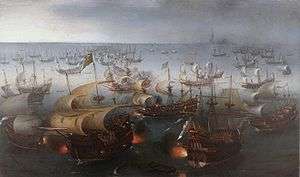
In England, the boost to national pride from the defeat of the Spanish invasion attempt lasted for years and Elizabeth's legend persisted and grew long after her death. Repulsing the Spanish naval force may have given heart to the Protestant cause across Europe and the belief that God was behind the Protestants.[70] This was shown by the striking of commemorative medals that bore variations on the inscription, "1588. Flavit Jehovah et Dissipati Sunt" – with "Jehovah" in Hebrew letters ("God blew, and they are scattered"), or He blew with His winds, and they were scattered. There were also more lighthearted medals struck, such as the one with the play on the words of Julius Caesar: Venit, Vidit, Fugit (he came, he saw, he fled). The victory was acclaimed by the English as their greatest since Agincourt.
The memory of the victory over the Armada was evoked during both the Napoleonic Wars and the Second World War, when Britain again faced a substantial danger of foreign invasion. The Armada Memorial in Plymouth was constructed in 1888 to celebrate the tercentenary of the defeat of the Spanish Armada.[71]
Historiography
Knerr (1989) has reviewed the main trends in historiography over five centuries.[72] For 150 years writers relied heavily on Petruccio Ubaldini's A Discourse Concernye the Spanish Fleete Invadinye Englande (1590), which argued that God decisively favoured the Protestant cause. William Camden (1551–1623) pointed in addition to elements of English nationalism and the private enterprise of the sea dogs. He also emphasized that the Duke of Medina Sidonia was an incompetent seaman. David Hume (1711–1776) praised the leadership of Queen Elizabeth. However the Whig historians, led by James A. Froude (1818–1894), rejected Hume's interpretation and argued that Elizabeth was vacillating and almost lost the conflict by her unwillingness to previously spend enough to maintain and supply the Royal Navy's fleet of ships. Scientific modern historiography came of age with the publication of two volumes of primary documents by John K. Laughton in 1894. This enabled the leading naval scholar of the day Julian Corbett (1854–1922) to reject the Whig views and turn attention to the professionalization of the Royal Navy as a critical factor. Twentieth-century historians have focused on technical issues, such as the comparative power of English and Spanish naval guns and the degree of naval battle tactics credit due Francis Drake and Charles Howard. Inclement weather in the English Channel and on the oceans at the time has always been cited as a major factor to the outcome.
Panorama
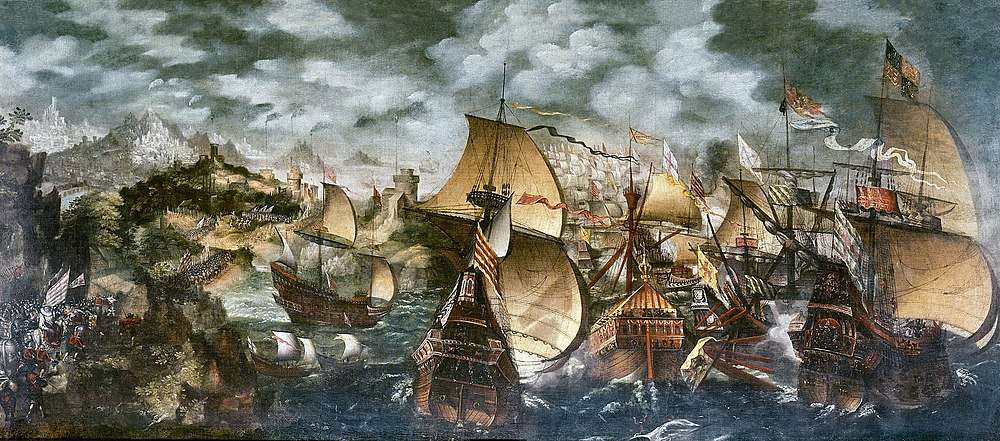
In popular culture
- The Battle of Gravelines and the subsequent chase around the northern coast of Scotland form the climax of Charles Kingsley's 1855 novel Westward Ho!, which in 1925 became the first novel to be adapted into a radio drama by BBC.[76]
- The armada is referenced by Uncharted Waters: New Horizons, a video game for Super Nintendo Entertainment System by Koei Tecmo. The armada in that representation is commanded by the fictional Commander Ezequiel.
- The 2007 film Elizabeth: The Golden Age contains a heavily fictionalized retelling of the Spanish Armada and the Battle of Gravelines.
See also
References
Notes
- Mattingly p. 401: "the defeat of the Spanish armada really was decisive"
- Parker & Martin p. 5: "an unmitigated disaster"
- Vego p. 148: "the decisive defeat of the Spanish armada"
- Lucy Hughes-Hallett notes the action off Gravelines "was the fight which would enter English history books as 'the defeat of the Spanish Armada', but to those who took part in it the engagement appeared inconclusive. By the end of it the Armada was battered but still battleworthy, while the English were almost entirely out of ammunition". Hughes-Hallett, Lucy: Heroes: A History of Hero Worship. Knopf Doubleday Publishing Group, 2010. ISBN 9780307485908, p. 327.
- "The 1588 campaign was a major English propaganda victory, but in strategic terms it was essentially indecisive". Holmes, Richard; Marix Evans, Martin: Battlefield: Decisive Conflicts in History. Oxford: Oxford University Press, 2007. ISBN 9780191501173, p. 108.
- According to José Alcalá-Zamora Queipo de Llano, "the confused and partial news of the indecisive naval actions fought between both naval formations in the English Channel were transformed into adulatory, courtier and political victorious reports". Alcalá-Zamora, José N.: La empresa de Inglaterra: (la "Armada invencible": fabulación y realidad). Madrid: Real Academia de la Historia, 2004. ISBN 9788495983374, p. 20.
- Parker & Martin p. 245
- Alcalá-Zamora p 56
- Richard Holmes 2001, Battlefield: Decisive Conflicts in History, p. 858: "The 1588 campaign was a major English propaganda victory, but in strategic terms it was essentially indecisive"
- Mattingly 362
- Colin Martin, Geoffrey Parker, The Spanish Armada, Penguin Books, 1999, ISBN 1-901341-14-3, p. 40.
- Colin Martin, Geoffrey Parker,The Spanish Armada, Penguin Books, 1999, ISBN 1-901341-14-3, pp. 10, 13, 19, 26.
- Kinard, Jeff. Artillery: An Illustrated History of Its Impact. p. 92.
- Burke, Peter. The New Cambridge Modern History: Volume 13, Companion Volume.
- Kamen, Henry (2014). Spain, 1469-1714: A Society of Conflict. Routledge. p. 123.
- Lewis, Michael.The Spanish Armada, New York: T.Y. Crowell Co., 1968, p. 184.
- John Knox Laughton,State Papers Relating to the Defeat of the Spanish Armada, Anno 1588, printed for the Navy Records Society, MDCCCXCV, Vol. II, pp. 8–9, Wynter to Walsyngham: indicates that the ships used as fireships were drawn from those at hand in the fleet and not hulks from Dover.
- Lewis, p. 182.
- Aubrey N. Newman, David T. Johnson, P.M. Jones (1985) The Eighteenth Century Annual Bulletin of Historical Literature 69 (1), 108 doi:10.1111/j.1467-8314.1985.tb00698.
- Casado Soto, José L.: Atlantic shipping in sixteenth-century Spain and the 1588 Armada, in Rodríguez-Salgado, M. J. and Simon Adams (eds.): England, Spain and the Gran Armada, 1585–1604. Edinburgh: John Donald, 1991. ISBN 9780859763004, p. 122.
- Garrett Mattingly rejects old estimations, makes a recount and concludes: "So, lost, at most, 31 ships (not 41), 10 pinnaces at most (not 20), two galleasses (not three), one galley. Total, not more than 44 (not 65), probably five or six and perhaps a doze less." Mattingly, Garrett: The Armada. Boston: Houghton Mifflin, 1987. ISBN 9780395083666, p. 426.
- Lewis p. 208
- Lewis pp. 208–09
- Hanson p. 563
- "The Safeguard of the Sea, A Naval History of Britain, 660–1649", N. A. M. Rodgers, Penguin, 2004, pp. 263–269
- John A. Wagner (2010). Voices of Shakespeare's England: Contemporary Accounts of Elizabethan Daily Life: Contemporary Accounts of Elizabethan Daily Life. ABC-CLIO. p. 91. ISBN 9780313357411.
- Colin Martin; Geoffrey Parker (1999). The Spanish Armada (revised ed.). Manchester University Press. p. 5. ISBN 9781901341140.
- Elliott p.333
- Oxford English Dictionary, 'armada'
- Waller, Maureen (2006). Sovereign Ladies: The Six Reigning Queens of England. New York: St. Martin's Press. p. 115. ISBN 978-0-312-33801-5.
- Pendrill, Colin (2002). Spain 1474–1700:The Triumphs and Tribulations of Empire. Bristol: Heinemann. p. 286. ISBN 978-0435-32733-0. "If the Armada is not as successful as we hoped but yet not entirely defeated, then you may offer England peace on the following terms. The first is that in England the free use and exercise of our Holy Catholic faith shall be permitted to all Catholics, native and foreign, and that those that are in exile shall be permitted to return. The second is that all the place in my netherlands which the English hold shall be restored to me and the third that they shall recompense me for the injury they have done me, my dominions and my subjects, which will amount to an exceeding great sum. With regard the free exercise of Catholicism, you may point out to them that since freedom of worship is permitted to the huguenots of France, there will be no sacrifice of dignity in allowing the same privilege to Catholics in England." April 1588, Philip II to the Duke of Parma.
- Hart, Francis Rußel, Admirals of the Caribbean, Houghton Mifflin Co., 1922, pp. 28–32, describes a large privateer fleet of 25 ships commanded by Drake in 1585 that raided about the Spanish Caribbean colonies.
-

- Hutchinson, Robert. "10 things you (probably) didn’t know about the Spanish Armada". BBC History Extra, April 2005. Retrieved 5 April 2020
- Wagner, John (1999). Historical Dictionary of the Elizabethan World; Britain, Ireland, Europe, and America. Oxford and New York: Routledge. p. 45. ISBN 978-1-57958-269-2. Retrieved 16 October 2013.
- Ezard, John. "Why we must thank the Turks, not Drake, for defeating the Armada". The Guardian, 1 June 2004. Retrieved 5 April 2020
- Coote, Stephen (2003). Drake, The Life and Legend of an Elizabethan Hero. London: Simon & Schuster UK Ltd. pp. 248–52. ISBN 978-0-7432-2007-1. Retrieved 16 October 2013.
- Garrett Mattingly, The Invincible Armada and Elizabethan England (Ithaca, NY: Cornell University Press, 1963), pp. 12–13.
- Colin Martin, Geoffrey Parker,The Spanish Armada, Penguin Books, 1999, ISBN 1-901341-14-3, p. 94, gives 30,500 and raised to 30,000 infantry and 2,000 cavalry on p.96. Also, the hoax paper The English Mercurie published by Authoritie, Whitehall 23 July 1588, Imprinted at London by Chriss Barker, Her Highnesse's Printer, 1588, otherwise states fairly accurately, p. 3, "...all the Spanish troops in the Netherlands, and consists of thirty thousand Foot and eighteen hundred Horse."
- The Spanish Armada : Sir Francis Drake
- Colin Martin, Geoffrey Parker,The Spanish Armada, Penguin Books, 1999, ISBN 1-901341-14-3, p. 185.
- Colin Martin, Geoffrey Parker,The Spanish Armada, Penguin Books, 1999, ISBN 1-901341-14-3, p. 153.
- Mcdermott. England and the Spanish Armada. p. 260
- Patrick Fraser Tytler (1833), Life of Sir Walter Raleigh, Edenburgh: Oliver & Boyd; [etc., etc.], OCLC 3656130, OL 6949907M
- Israel, J. I. and Parker, G. (1991) "Of Providence and Protestant Winds: the Spanish Armada of 1588 and the Dutch armada of 1688", in: The Anglo-Dutch moment. Essays on the Glorious Revolution and its world impact. Cambridge U.P., ISBN 0-521-39075-3; pp. 349–51
- Motley, John Lothrop (1860). "XVII.1587". History of the United Netherlands from the Death of William the Silent to the Synod of Dort. 1586–89. London: John Murray. 4194.
- "Hellburners" (PDF). Archived from the original (PDF) on 28 February 2007. (143 KiB).
- Coote, Stephen (2003). Drake. London: Simon & Schuster. p. 259. ISBN 978-0-7432-2007-1. Retrieved 5 December 2009.
- Colin Martin, Geoffrey Parker, The Spanish Armada, Penguin Books, 1999, ISBN 1-901341-14-3, pp. 189–90
- Battlefield Britain: Episode 4, the Spanish Armada
- John Guy (2016). . Elizabeth: The Forgotten Years. Viking. p. 119.
- Damrosh, David, et al. The Longman Anthology of British Literature, Volume 1B: The Early Modern Period. Third ed. New York: Pearson Longman, 2006.
- John Guy (2016). Elizabeth: The Forgotten Years. Penguin Books Limited. ISBN 978-0-241-96364-7.
- Brian Fagan, The Little Ice Age: How Climate Made History 1300–1850, New York: Basic Books, 2000
- Mattingly, Garrett (1959). The Armada. Boston: Houghton Mifflin Harcourt. p. 369. ISBN 978-0-395-08366-6. LCCN 87026210. OCLC 16806339. OL 2396450M. ID information is for the 1987 reprint.. The English Lord Deputy ordered the English soldiers in Ireland to kill Spanish prisoners, which was done on several occasions instead of asking for ransom as was common during that period.
- Winston S. Churchill, "The New World", vol. 3 of A History of the English-Speaking Peoples, (1956) Dodd, Mead & Co., New York, p. 130.
- "In the end as many as two-thirds of the armada's original complement of 30,000 died and for every one killed in battle or perishing of their wounds another six or eight died due to (non-combat losses)", Hanson p. 563
- SparkNotes: Queen Elisabeth – Against the Spanish Armada
- "Europe - MSN Encarta". Archived from the original on 31 October 2009.
- R. O. Bucholz, Newton Key. Early modern England 1485–1714: a narrative history (John Wiley and Sons, 2009). ISBN 978-1-4051-6275-3 p.145
- John Hampden Francis Drake, privateer: contemporary narratives and documents (Taylor & Francis, 1972). ISBN 978-0-8173-5703-0 p.254
- Fernández Duro, Cesáreo (1972). Armada Española desde la Unión de los Reinos de Castilla y Aragón. Museo Naval de Madrid, Instituto de Historia y Cultura Naval, Tomo III, Capítulo III. Madrid. p.51
- Fernández Duro, Cesáreo (1972). Armada Española desde la Unión de los Reinos de Castilla y Aragón. Museo Naval de Madrid, Instituto de Historia y Cultura Naval, Tomo III, Capítulo III. Madrid. p. 51
- Tenace 2003, pp. 855–882.
- J. H. Elliott. La Europa dividida (1559–1598) (Editorial Critica, 2002). ISBN 978-84-8432-669-4 p.333
- Aubrey N. Newman, David T. Johnson, P.M. Jones (1985) The Eighteenth Century Annual Bulletin of Historical Literature 69 (1), 93–109 doi:10.1111/j.1467-8314.1985.tb00698.
- Geoffrey Parker, 'The Dreadnought Revolution of Tudor England', Mariner's Mirror, 82 (1996): 273.
- Geoffrey Parker, "The 'Dreadnought' Revolution of Tudor England", Mariner's Mirror, Aug 1996, Vol. 82, Issue 3, pp. 269–300
- Geoffrey Parker, "Why the Armada Failed", History Today, May 1988, Vol. 38 Issue 5, pp. 26–33
- Richard Holmes 2001, p. 858: "The 1588 campaign was a major English propaganda victory, but in strategic terms it was essentially indecisive"
- Worth, Richard (1890). History of Plymouth: From the Earliest Period to the Present Time. Plymouth: W. Brenden. pp. 51–54.
- Douglas Knerr, "Through the "Golden Mist": a Brief Overview of Armada Historiography." American Neptune 1989 49(1): 5–13.
- Aled Jones (5 May 2005). Transactions of the Royal Historical Society: Sixth Series. Cambridge University Press. pp. 129–. ISBN 978-0-521-84995-1. Retrieved 8 October 2011.
- The Battle of Gravelines by Nicholas Hilliard at bbc.co.uk
- Aled Jones (5 May 2005). Transactions of the Royal Historical Society: Sixth Series. Cambridge University Press. pp. 129–. ISBN 978-0-521-84995-1. Retrieved 8 October 2011.
- Briggs, Asa. The BBC: The First Fifty Years. Oxford: Oxford UP, 1985. 63.
Bibliography
- Corbett, Julian S. Drake and the Tudor Navy: With a History of the Rise of England as a Maritime Power (1898) online edition vol. 1; also online edition vol. 2
- Cruikshank, Dan: Invasion: Defending Britain from Attack, Boxtree Ltd, 2002 ISBN 0-7522-2029-2
- Fernández-Armesto, Felipe. The Spanish Armada: The Experience of War in 1588. (1988). 336 pp.
- Froude, James Anthony. The Spanish Story of the Armada, and Other Essays (1899), by a leading historian of the 1890s full text online
- Hanson, Neil. The Confident Hope Of A Miracle: The True History Of The Spanish Armada Random House, 2011, ISBN 9781446423226
- Kilfeather T. P.: Ireland: Graveyard of the Spanish Armada, Anvil Books Ltd, 1967
- Knerr, Douglas. "Through the "Golden Mist": a Brief Overview of Armada Historiography." American Neptune 1989 49(1): 5–13. ISSN 0003-0155
- Konstam, Angus. The Spanish Armada: The Great Enterprise against England 1588 (2009)
- Lewis, Michael. The Spanish Armada, New York: T.Y. Crowell Co., 1968.
- Mcdermott, James (2005). England and the Spanish Armada: The Necessary Quarrel. New Haven, CT: Yale University Press. ISBN 978-0-3001-0698-5.
- Martin, Colin, and Geoffrey Parker. The Spanish Armada (2nd ed. 2002), 320pp by leading scholars; uses archaeological studies of some of its wrecked ships excerpt and text search
- Martin, Colin (with appendices by Wignall, Sydney): Full Fathom Five: Wrecks of the Spanish Armada (with appendices by Sydney Wignall), Viking, 1975
- Mattingly, Garrett. The Armada (1959). the classic narrative excerpt and text search
- Parker, Geoffrey. "Why the Armada Failed." History Today 1988 38(may): 26–33. ISSN 0018-2753. Summary by leadfing historian.
- Pierson, Peter. Commander of the Armada: The Seventh Duke of Medina Sidonia. (1989). 304 pp.
- Rasor, Eugene L. The Spanish Armada of 1588: Historiography and Annotated Bibliography. (1992). 277 pp.
- Rodger, N. A. M. The Safeguard of the Sea: A Naval History of Britain 660–1649 vol 1 (1999) 691 pp; excerpt and text search
- Rodriguez-Salgado, M. J. and Adams, Simon, eds. England, Spain, and the Gran Armada, 1585–1604 (1991) 308 pp.
- Tenace, Edward (2003), "A Strategy of Reaction: The Armadas of 1596 and 1597 and the Spanish Struggle for European Hegemony", English Historical Review, 118 (478): 855–82, doi:10.1093/ehr/118.478.855
- Thompson, I. A. A. "The Appointment of the Duke of Medina Sidonia to the Command of the Spanish Armada", The Historical Journal, Vol. 12, No. 2. (1969), pp. 197–216. in JSTOR
- Vego, Milan N. (2013). Naval Strategy and Operations in Narrow Seas. Routledge. ISBN 9781136317941.
- Alcalá-Zamora, José N. (2004). La empresa de Inglaterra: (la "Armada invencible" : fabulación y realidad). Taravilla: Real Academia de la Historia ISBN 978-84-95983-37-4
Popular studies
- Hanson, Neil. The Confident Hope of a Miracle. The True History of the Spanish Armada. Knopf (2003), ISBN 1-4000-4294-1.
- Holmes, Richard. The Oxford Companion to Military History. Oxford University Press. 2001. ISBN 978-0-19-860696-3
- McKee, Alexander. From Merciless Invaders: The Defeat of the Spanish Armada. Souvenir Press, London, 1963. Second edition, Grafton Books, London, 1988.
- Graham, Winston. The Spanish Armadas (1972; reprint 2001) ISBN 0-14-139020-4
- Parker, Geoffrey Mariner's Mirror. 'The Dreadnought Revolution of Tudor England', 82 (1996): pp. 269–300.
- Lewis, Michael The Spanish Armada First published Batsford, 1960 – republished Pan, 1966
- Padfield, Peter. Armada: A Celebration of the Four Hundredth Anniversary of the Defeat of the Spanish Armada, 1588–1988. Gollancz (1988). ISBN 0-575-03729-6
- McDermott, James. England & the Spanish Armada: The Necessary Quarrel (1990) ISBN 0-7317-0127-5
- Whiting J. R. S. The Enterprise of England: The Spanish Armada (1988) Sutton Publishing (1995) ISBN 0-86299-476-4
- Wernham A. B.. The Return of the Armadas: the Later Years of the Elizabethan War against Spain, 1595–1603, ISBN 0-19-820443-4
- Howarth, David The Voyage of the Armada: The Spanish Story (1981). ISBN 0-00-211575-1
- Kilfeather T. P. Ireland: Graveyard of the Spanish Armada (Anvil Books, 1967)
- Graham, Winston. The Spanish Armadas (1972; reprint 2001) ISBN 0-14-139020-4
- Davies J. J. (1909) Historic Bourne, etc.
External links
| Wikimedia Commons has media related to Spanish Armada. |
- The Story of the Tobermory Spanish Galleon
- The Defeat of the Spanish Armada. Insight into the context, personalities, planning and consequences. Wes Ulm
- English translation of Francisco de Cuellar's account of his service in the Armada and on the run in Ireland
- Elizabeth I and the Spanish Armada – a learning resource and teachers notes from the British Library
- The story of the Armada battles with pictures from the House of Lords tapestries

